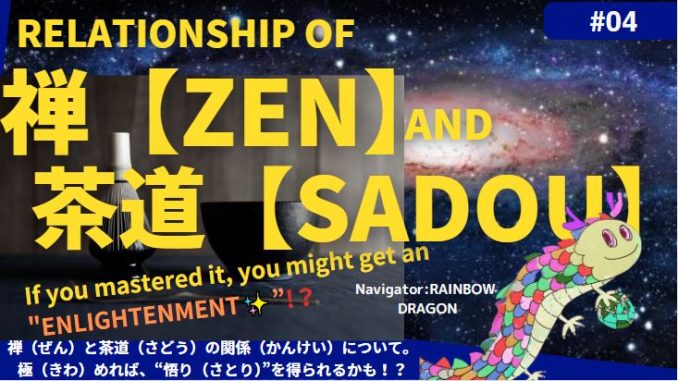
CONTENTS:
1. What’s 禅【ZEN】? It’s one of the world famous method of Buddhism and Apple’s SEO Steve Jobs was into it, too.
▶ESSAY<Coming Soon>: Morning bloom of RIKYUU. Gedding rid of unimportant things and leave only precious thigs for you…ZEN style is similar to KONMARI method!
▶3. About Japanese 仏教【BUKKYOU(Buddhism)】
▶A founder of 禅宗【ZEN-SHUU(ZEN-BUDDHISM)】was 達磨【DARUMA(Bodhidharma)】
2. In the early history of Japan, 茶【CHA/TEA】 was drunk at 禅寺【ZEN TEMPLE】and many of famous tea masters were ZEN
3. Basically, a 禅語【ZENGO(ZEN-Word)】is displayed on the 床の間【TOKONOMA(Alcove)】in a tea room and it is a theme of the tea ceremony.
4. About Popular 禅語【ZEN-GO(ZEN-words)】on hanging scrolls become a theme of the tea ceremony
▶ESSAY:To maintain silence in the tea room…4 ways and 1 way you might feel eternal.
5. Why 侘び寂び【WABI-SABI】, one of the most important values in SADOU, is needed for Japan now?
1.What’s 禅【ZEN】? It’s one of the methods to reach an enlightenment of Buddhism started by 達磨【DARUMA】.
▶Japanese 仏教【BUKKYOU(Buddhism)】
Have you heard a word 禅【ZEN】? It is said that it’s one of the ways to reach 悟り【SATORI(Enlightenment)】in Buddhism. Through meditation with 座禅【ZA-ZEN(Sitting ZEN)】,through away your unnecessary and extra thoughts, without thinking anything and become 無【MU(Nothing, Zero)】state. Then, find an answer which is inside of you and try to close an Enlightenment state named 悟り【SATORI】.

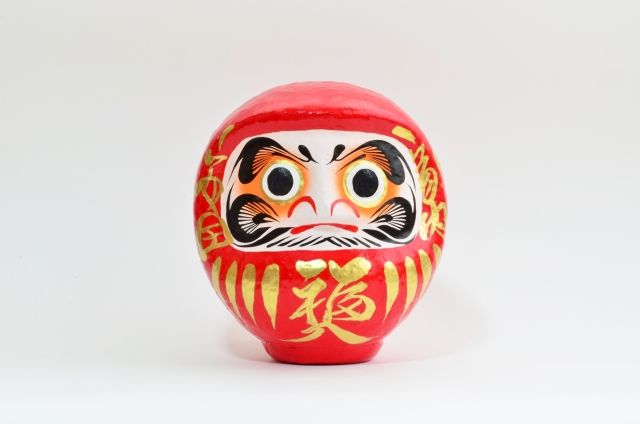
▶A founder of 禅宗【ZEN-SHUU(ZEN-BUDDHISM)】was 達磨【DARUMA(Bodhidharma)】

The book named 禅【ZEN】written by 鈴木大拙【SUZUKI-DAISETSU】was introduced to America and it became popular in 1950’s.
ZEN sprit influenced to American Hippie culture as same as Indian’s YOGA and other thoughts of oriental philosophies.

Recently, ZEN become a topic because Apple’s CEO Steve Jobs was into it.
I think ultimately simple and sophisticated design of Apple products is based on ZEN philosophy.
On the ultimately simple white screen or device like pc, the apple’s symbol mark increases it’s presence vividly.
At the same time, for example i-phone unite digital represented by 0 or 1 , and touch the screen by human fingertips and oversize or shrinks by moving fingers sensation.


2. In it’s early history,茶【CHA/TEA】in Japan was drunk at 禅寺【ZEN TEMPLE】and much of famous tea masters were ZEN monks.
A Buddhist monk 栄西【EISAI】who went to 宋【SOU】 in 15C as an exchange monk was a monk of 臨済宗【RINZAI-SYUU(RINZAI-sect)】of 禅宗【ZENSHUU(ZEN-SECT)】. He brought back 茶【CHA(Tea)】to Japan and a custom to drink tea before ZEN meditation in ZEN temple like 大徳寺【DAITOKUJI】.
At that age ( from end of 鎌倉【KAMAKURA】to 室町【MUROMACHI】era )a lot of arts like paintings, poems, architects and dramas were influenced by 禅【ZEN】Style.
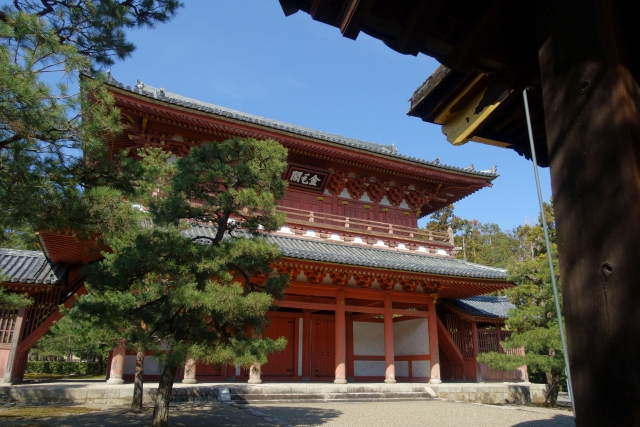
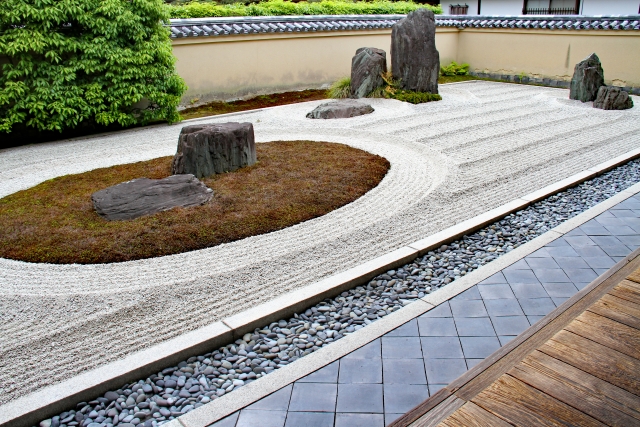
Most of famous founders of SADOU in early time like 村田珠光【MURATA-JYUKOU】, 武野紹鴎【TAKENO JYOUOU】and the most famous tea master,千利休【SENNO RIKYUU】. JYOUOU and RIKYUU were merchants of 堺【SAKAI】, but They took permissions called 印可【INGA】from 大徳寺【DAITOKU-JI】ZEN Temple. 印可【INGA】is an application or certification that improves some ones have reached 悟り【SATORI】by answering question of 禅問答【ZEN-MONDOU(ZEN questions and answers)】.
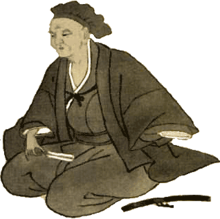
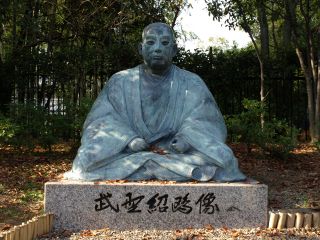
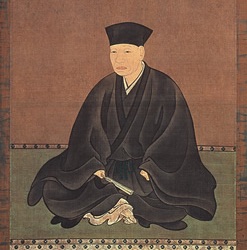
JYOUOU and RIKYUU were merchants of 堺【SAKAI】, but They took permissions called 印可【INGA】from 大徳寺【DAITOKU-JI】ZEN Temple. 印可【INGA】is an application or certification that improves some ones have reached 悟り【SATORI】by answering question of 禅問答【ZEN-MONDOU(ZEN questions and answers)】.
3. Basically, a 禅語【ZENGO(ZEN-Word)】is displayed on the 床の間【TOKONOMA(Alcove)】in a tea room and it is a theme of the tea ceremony.
Traditional architect style of お茶室【O-CHASHITU(Tea Room)】is 禅宗様式【ZENSHUU-STYLE】.
In a very small and so simple style room, there is a 床の間【TOKONOMA(Alcove)】.During Tea Ceremony, definitely 3 set of お軸/掛け軸【OJIKU/KAKEJIKU(Hanging Scroll), 花【HANA(Flower)】and 香合【KOUGOU(Seramic small container for Incenses)】are displayed on it.

Basically hanging scrolls displayed in tea ceremonies are (it might be different depend on it’s sect though,) 禅語【ZENGO(ZEN-Words)】written by monks of 大徳寺【DAITOKUJI-Temple】.
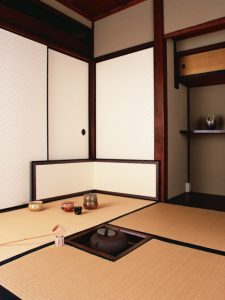
And a content written on the hanging scroll become a theme of that tea ceremony.
All tea tools like tea bowls, a name of a tea scoop, a name of sweet so on are arranged followed by the theme( It is interesting and a joy for guests to find them one by one which are hidden by host. The more you are familiar with the way of tea, the more you would find these points and it would become an lifetime-endless hobby ).
Then, when you visited the tea ceremony and ZEN words are on the alcove, it might be said you and hosts are training of 禅【ZEN】by feeling and thinking about the word deeply.
4. About popular 禅語【ZEN-GO(ZEN-words)】which is often used on hanging scroll in a tea room and become the theme of a tea ceremony.
A STORY ABOUT 喫茶去【KISSAKO】;Literally means 〝Well, please have some tea“.
In the age of 唐【TOU】 of China in 8C, two monks of Zen Buddhism came to see趙州-和尚【A Virtuous monk CHOU SHYUU 】(778-897).
Mr.Chou Shyuu asked one monk, “Have you ever been here?” and the monk said “Yes”.
Then, Chou Shyu said “ Well, have some tea”.
Next time, Chou Shyuu asked the other monk “Have you ever been here?” And the monk said “No. It’s my first time”. Then, Chou Shyuu said “ Well, have some tea”.The owner of the temple who saw these asked Chou Shyuu “Why do you say the same thing to the person who came once and the one who came the first time?”.Then, Chou Shyuu said “Mr.!” The owner answered “Yes!”. Then, Chou Shyuu said “Well, have some tea”.
How do you think of it?
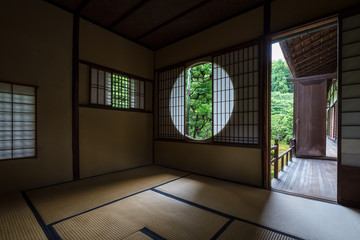
It is one of 禅問答【ZEN-Mondou ( ZEN Buddhism Questions and Answers)】.
A master asks something about kind of you know, philosophical, to his disciples.
Then, the answer was enough, the master get to know his disciple has reached an enlightenment.
The disciple get 印可【INGA( Certification of Enlightenment)】from the master after he passed the last examinate question.
It might be curious that the master only say the same thing to other persons who’s situations are different each.
It has been difficult to even Japanese persons and there are many ways to understand.
One says:
Everyone need 修行【SHUGYOU(Training for getting an enlightenment)】more.
喫茶去【KISSAKO】 also literally means ”Just have some tea and leave”.喫茶【KISSA】means “Drinking some tea” and 去【KO】means “leave”. So, it doesn’t mean in casual meaning, only just having some tea, but also having rather strict meaning.
Another says:
The monk 趙州【CHOU SHYUU】 says the same thing to every ones who are in different situations, because he meet everyone without any prejudice.
If you judge someone from past experiences, you can not see him now.
Like other ZEN word 一期一会【ICHIGO-ICHIE】: One Time-One Meeting, even if you meet someone many times, the situation and mind are different each time. You can not meet someone at the same way. SO, enjoy the moments of your meeting every time, from the deep of your heart and all of your senses.

Drinking tea in ZEN way is one of the ways to be mindfulness without any dust of your heart.
Then, you can say 喫茶去【KISSAKO】to every-one: acquaintances, meeting for the first time, and someone who is wondering about something, so on.
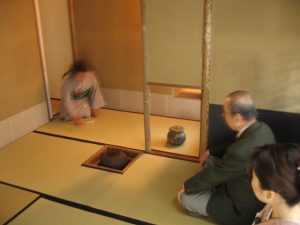
The following Zen words are often used at tea parties.
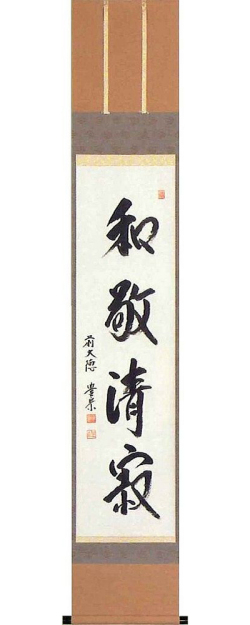
●喫茶去【KISSAKO】:Welcome to our tea room. Any way, please feel free to have a bowl of tea without difficult manners nor things.
●日々是好日【NICHI NICHI KORE KOUJITSU】:Even it is a rainy day, a windy, a snowy or a sunny day, it is a fine day.
●一期一会【ICHIGO-ICHIE】:Today, this time, this moment is only one time and n, this moment is only one time and never happen again. You can not meet the same person in the same situation. So, please appreciate enough every moments as if they are the last times.
●和敬清寂【WA-KEI-SEI-JYAKU(Harmony-Respect-Purify-Silence/Serenity)】
When Harmonized【和】, Respect【敬】each other, and Purify【清】 of things and mind, all happened together,then Silence【寂】 appears.
●花紅柳緑【KA-KOU RYUU-RYOKU】 Flowers red and willow green.The flowers are red and the willow is green. nature as it is
A word that praises beauty. Furthermore, it also means that there is no point in being envious of those around you.
●紅炉一点雪【KOURO ITTEN NO YUKI】 : The heart of an excellent master burns red
It is like a furnace, and a piece of snow that falls into it disappears in an instant.
Irrelevant thoughts that appear one after another disappear instantly, and unlike ordinary people, they do not spread out into two or three points.
●白珪尚可磨【HAKKI NAO MIGAKU BESHI】:It is important to keep brushing a beautiful white jade even it is completed.
●知足【CHISOKU】Knowing to be enough is important.
●壺中日月長【KOTYUU-JITSUGETSU-NAGASHI】
In China’s old bool named 後漢書【GO-KANSYO】, There is a story that an old medicine seller
after his shop closed, people would go inside the jar and enjoy a wonderful, fairy-like world.
When the government official who forced himself to go with me into the jar spends several days there, in this world, he returns home.
It has been several decades.
It evolved from this point, and even in the space of a small tea room that resembles a pot, it has a rich and spiritual feeling.It is also used to mean that you can enjoy your life.
●本来無一物【HONRAI-MUICHIMOTSU】
Humans are born with nothing, so I never thought of things as difficult. Or because all things are empty,there is nothing to be attached to.
It is said that all things are 空【KUU】“empty”:This is the true essence of 禅【ZEN】, which is repeatedly preached in 般若心経【HANNYA-SINGYOU】famons as the most short and important sutra.
●無一物中無尽蔵 【MU ICHIMOTSU CYUU-MUJINZOU】
Inexhaustible among the things that are inexhaustible : On the other hand, how much is there in the things that are inexhaustible?
There is also a Zen saying that it contains infinite things that cannot be lost even if you take them away.
Is it true that everything is given to us when we are free of attachment?
●〇(円相)【EN-SOU】It means harmonized university by perfect round.
Why don’t you try finding your favorite Zen words?

Leave a Reply